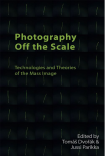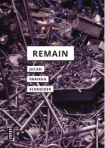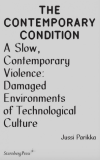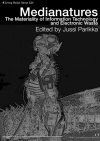Archive
The Mediocene And the Lab Scene
The Mediocene conference takes place later this month in May in Weimar. Organized by the IKKM, the conference picks up on the Anthropocene from a specific media-focused vantage point. In the organizers words, “The concept of the Mediocene […] sees media and medial processes as epoch-making. As a determining force, they leave their permanent imprint on the world, affecting animate and inanimate nature alike — human existence, technology, society, and the arts as well as the shape, organization and history of the global habitat itself.”
My take draws on our current laboratory-project, and below is a short (draft!) text of the beginning of the talk still in the process of writing and without a full range of references. The idea of the talk is to set the laboratory as this particular term, an imaginary and a fever around which multiple scales of planetary media come to the fore. It will also discuss topics especially in the art and technology-nexus including briefly the emergence of art labs in the Cold War institutions of technical media (a topic that will be well covered by Ryan Bishop and John Beck in their new work), as well as experimental work in the arts about the lab, including Bureau D’Etudes on the Laboratory Planet as well as probably such work as Neal White’s on post-studio. Any further thoughts, tips and ideas are warmly appreciated.
The Lab is the Scene
One could be forgiven for thinking that the world’s nothing but a lab. From endorsing the centrality of the factory as a key site to understand modernity and as the site of production, material transformation, commodity culture, labour relations, pollution and what not, the laboratory seems to have in some accounts taken a similar role. It speaks to a range of topics of media and culture: historically, a central place of inventing and engineering technical media; thematically, one crucial vantage point for the multi-scalar operations that define the tie between the planetary (dis)order and its situated practices. It does however come with a legacy that is only partly about the science lab. Indeed, the other important lineage relates to the technology, engineering and design/art labs that throughout the 20th century started to offer a parallel narrative: experimentation, a demo or die-attitude (at the MIT Media Lab, see for example Halpern 2015), prototyping, and more. Hence this lab story of experimental culture is not restricted to the science lab as if a separate entity from the arts and humanities; and in any case, the science labs of many kinds have already had their fair share of attention from social scientists and humanities scholars, even post-studio artists up until the recent days with the continuing enthusiasm for CERN residencies.
The proliferation of laboratories outside the strict confines of the science lab seems to have taken place with the entry of a range labs of different kinds: design labs, maker labs, hack labs, media archaeology labs, studio-labs, digital humanities labs, humanities, critical humanities labs, media labs and critical media labs – and then, fashion labs, brew labs, coffee labs, gadget labs, creativity labs, the list goes on. The usual thought would be that this is part of the metaphoric inflation of the meaning, site, scientificity of the laboratory that brands a particular attitude to postmodern culture. Of course, as Henning Schmidgen echoing the likes of Peter Galison and others points out, “the laboratory is undergoing a process of dissolution and dispersal,” with the massive distributed networks that constitute the laboratory now (think of the Human Genome project, think of CERN) but this dissolution and dispersal happens on other levels too, as the examples pertaining to humanities and media labs demonstrate. There’s almost nothing that could not be a lab. But perhaps the lab is itself symptom more than the answer, and as such, a trigger to consider issues of the mediocene in art and technology; issues such as scales of data, infrastructure and different methodologies. It becomes itself a rather fluidly moving term not merely designating a particular specialist place but also a particular project about the lab imaginary. Here, the notion of the project is crucial due to its future-oriented sense.
A focus only on the most recent would miss the point how the laboratory was already early on a contested term – especially when going on in the pre-scientific laboratories and their heterogeneous sets of spaces and practices that avoid too easily to be pinned down only as steps towards the perfection of a form – but the problem about the term persisted also later, during the emergence of the science laboratory.
As historians of science have noted, the lab as elaboratory was one formative way of understanding what then went on in the early modern spaces preceding labs. Elaborating materials for medicine and chemistry, working with the variety of materials in ways that was not merely under human control: the) elaboratory was a place where to let things go their way, even if offering a stage by way of the thermomedia control (see Nicole Starosielski’s work on temperatures and media) that allowed the transformations to be accelerated from earth time to lab time. Interestingly enough, such a broader understanding of labs and elaboration in relation to natural formations persisted; Sir Humphry Davy’s voiced in 1815 that “the soil is the laboratory in which the food is prepared.” In 1860 in a very different scientific context regarding the Physical Geographies of the Sea, Louis Ferdinand Alfred Maury spoke of the sea as the “a laboratory in which wonders by processes the most exquisite are continually going on”, as a sort of an model for understanding atmospheric movements even.
Indeed, reverse from our current laboratory fever some 100 years and a bit more, and shift the focus to Bangor in Wales where Sir William Thomson, 1st Baron Kelvin of, indeed, the kelvin fame of temperature measurement but also having worked with maritime compasses among any other things crucial for planetary media. Thomson opening the new spaces of physics and Chemistry labs in 1885 at University of Bangor seemed to be offering a rather extended way of understanding the topic. Let’s quote him:
“The laboratory of a scientific man is his place of work. The laboratory of the geologist and naturalist is the face of this beautiful world. The geologist’s laboratory is the mountain, the ravine, and the seashore. The naturalist and the botanist go to foreign lands, to study the wonders of nature, and describe and classify the results of their observations.”
Thomson was no mere romantic fool of course, but a man of modern science. He was not haunted by a romantic longing to a past of gentleman travels across the planet observing this beauty of nature but more of a pragmatist. Also the field research must be tightly linked to the possibilities of the lab, its equipment and its techniques, so as to ensure there is a tight connection between the insides and the outsides (Gooday 790). A properly equipped lab is what ensures that the field itself becomes an extended part of the technical apparatus, a laboratory that spans across the territories of the planet. A lab is where scales meet, to remind of the ways in which Bruno Latour spoke of Louis Pasteur for example.
For a longer period medicine, chemistry and metallurgy, and then of course physics remained the central disciplines of the laboratory (see Gooday, Schmidgen 2011). 20th century brought technological laboratories into the scene: engineering and material labs, electronics labs to the varieties of other forms of centralised facilities that systematised the production of engineered culture. Much before there were things called media labs, labs were essential to media to become what they became in relation to the actual apparatuses as well as their impact on the thresholds of perception. Labs were one sorts of conditions for much of that work that came to be called media. Many of the labs in engineering were the institutions central to the backbone of various national and international infrastructures such as the Bell Labs, the centrality of “innovation labs” from Menlo Park to many others, and of course, the centrality of the art and technology labs of the Cold War that themselves were the grounding of so much of what we call now “media arts” and where the particular techniques of speculative, experimental use meet up with the other sort of speculative that is attached to forms of value creation.
The lab as place, invention and extension of “media” is part of the continuum of the technological work in labs and the artistic practices as one background to the notion of experimentation. The media and arts approaches produce a particular discourse, a particular stance on the experiment, but also in some cases a corporate take on a speculative mapping of scales that reach out spatially to planetary infrastructures as much as local scales as well as to the future-oriented dimension. Here, I believe there’s a way in which it resonates with the question of the Anthropocene as one of scales that map out the lab as something of an epistemological and medial arrangement that spans further than its space. This happens both discursively and in terms of its objects of knowledge: emerging from the Cold War period art-technology labs, or the studio-lab, it also becomes a scene where the continuum between technological culture and its creative practices are put into a conversation, creating the particular scene and the fantasy of visionary future-oriented experimental work inventing the media worlds to come. The Mediocene is this particular aesthetic-technological framing of scales (temporal, spatial, potential, not-yet actualised, speculative) and quite often, also in this arts-technology nexus it does happen through the hinge of the lab. Now, using the term, as is clear from already now, I am forced to ignore many current examples that also use the term in other ways that I will narrate in this talk. The term has multiple uses and as such, my version does not do justice to the full plethora of labs of critical, experimental practice as much as it connects the term to a particular different sort of a genealogy. Hence, bear with me, as I sketch some ideas.

The Steganographic Image
It’s the Conspiracy week at the Photographers’ Gallery in London and I was asked to write a short text on what lies inside the image (code). In other words, I wrote a short text on the Steganographic Image, and hiding messages in plain sight, although in this case, encoded “inside” a digital image. The image that tricks, the image that operates behind your back, or more likely, triggers processes front of your eyes, in plain sight, invisible. As I was reminded, this is also an idea that Akira Lippit has in a different context developed through Derrida. To quote Lippit (quoting at first Derrida): ‘”Visibility,” he says “is not visible.” Invisibility is folded into the condition of visibility from the beginning. There is no visibility that is not also invisible, no visibility that is not in some way always spectral.’One would be tempted to argue that this is where this consideration of the visual meets up with the history of cryptography, or ciphering and deciphering. Or as Francis Bacon put it in 1605 in ways part of the longer media archaeology of the steganographic image too: “The virtues of ciphers are three: that they be not laborious to write and read; that they be impossible to decipher; and, in some cases, that they be without suspicion.” It is especially this third virtue that remains of interest when looking at images without such suspicion: the most banal, tedius of pictures; a spectrality that conjurs up hidden passages, triggers and operations.
My short text can be found here online. It’s only scratching the steganographic surface.
A short preview of the text.
Hidden in Plain Sight: The Steganographic Image
Who knows what went into an image, what it includes and what it hides? This is not merely a question of the fine art historical importance of materials, nor even a media historical intrigue of chemistry, but one of steganography – hiding another meaningful pattern, perhaps a message, in data; inside text or an image. This image that is always more than. More than what? Isn’t it obvious from the amount of work gone into art-theoretical considerations of the inexhaustible meanings of the photographic image that it has always been a multiplicity: contexts, fluctuating meanings, readings and the insatiable desire to look at things in order to discover its depths.
As such, a steganographic inscription is neither a depth nor the plain surface but somewhere in between. In contemporary images made of data it refers to how the image can be coded as more than is seen, but also more than the image should do. The steganographic digital image can be executed; it includes instructions for the computer to perform. Photographs as part of a longer history of communication media are one particular way of saying more than meets the eye, but this image also connects to histories of secret communication from the early modern period, to more recent discussions in security culture, as well as fiction such as William Gibson’s novel Pattern Recognition (2003). Were J.G. Ballard’s 1950s billboard mysteries one sort of cryptographic puzzle that hid a message in plain visual sight?
After Arikan: Data Asymmetry
After our succesful exhibition of Burak Arikan’s work, Data Asymmetry, I am posting some of the interviews and material that came out of the exhibition.
Here’s a video interview we did with Arikan setting up the exhibition in the Winchester gallery in November 2016:
And then there’s the interview(s) in Furtherfield: Carleigh Morgan interviewed Burak in the part 1 of the interview about Data Asymmetry and myself in part 2 of the interview. The interview(s) address mapping as a collective experiment, networks as events, (art) methodologies of working with data and a lot of other topics related to internet culture.
The Last Pokestop
One does not need an episode of Black Mirror to imagine this quiet future-now landscape: the smaller and smaller rural towns and villages in Finland, emptied of jobs, paper factories, community halls and services.
First came the replacement of the abandoned paper mills with international corporate data server facilities. Gradually the towns turned only into pokestops for the random visitors passing by.

The 21st century Finnish version of the lyrics “This town, is coming like a ghost town” is the ghostly presence of a pokestop that is too far away. The last pokestop.
Denials of Service
I wrote a short text on “Denials of Service” for the just released new book There is no software, there are just services. (Meson Press and downloadable as an open access PDF).
The book, edited by Irina Kaldrack and Martina Leeker, asks if software is dead. This is not merely a rehashed Nietzschean proclamation so much as an observation about the current digital industry landscape where “the (re)emergence of the service paradigm […] challenges traditional business and license models as well as modes of media creation and use.” Indeed, perhaps software is replaced by services. “The short essays in this edited collection discuss how services shift the notion of software, the cultural technique of programming, conditions of labor as well as the ecology and politics of data and how they influence dispositifs of knowledge.”
Meson Press is a recent publishing initiative at Leuphana University, Luneburg. Here’s a short interview with Mercedes Bunz explaining the idea of the Press.
Code and Labour
The new issue of Cultural Studies Review follows up from the 2012 Code-conference that was held in Melbourne, at Swinburne University. The event was marvelous, thanks to the organizers. And now, Esther Milne and Anthony McCosker have edited a lovely special issues Coding Labour. With a line-up including Anna Munster, Ned Rossiter, Mark Cote,Rowan Wilken and many more – as well as for instance Meaghan Morris in the same issue – one can expect much.
My own article is about the slightly heretic crossbreeding of German media theory and cognitive capitalism. It briefly discusses the notion of cultural techniques as a way to elaborate cognitive capitalism in the context of practices and techniques of software, code and labour. Hence it ends up in a curious short example from the 1970s, the management and organisational arrangement of metaprogramming, as a way to discuss how we might approach techniques of “creative” work in software culture.
You can find the text here and below a short abstract.
This article addresses cultural techniques of cognitive capitalism. The author argues that to understand the full implications of the notion of cognitive capitalism we need to address the media and cultural techniques which conditions its range and applications. The article offers an expanded understanding of the labour of code and programming through a case study of ‘metaprogramming’, a software related organisation practice that offered a way to think of software creativity and programming in organisations. The ideas from the 1970s that are discussed offer a different way to approach creativity and collaborative and post-Fordist capitalism. The author brings together different theoretical perspectives, including German media theory and Yann Moulier Boutang’s thesis about cognitive capitalism. The wider argument is that we should pay more attention to the media archaeological conditions of practices of labour and value appropriation of contemporary technological capitalism as well as the cultural techniques which include ‘ontological and aesthetic operations’ that produce cultural, material situations.
Architecture’s Underbelly
One of the low points of architecture in 2013 was architect Zaha Hadid’s football stadium in Qatar. Designed for the forthcoming games of 2022, the main part of the discussion has been about whether it resembles a vagina or not.
Besides reducing architectural discourse to a pretend shock about female genitalia, the case is emblematic of how design is detached from the actual world conditions. Instead of engaging in any way with the reports about abusive working conditions in the construction sites of such stadiums for Qatar 2022, we are left debating the building’s pinky Freudian connotations. Despite the pseudo-feminist debate it raised, a rather sad moment for design. It actually just flags detachment of both architectural popular discourse and architects such as Hadid from a connection with things that might have some material meaning or a meaningful impact for those whose lives this has a direct lived relation.
The underbelly of star designers are: “long working hours, hazardous working conditions, the workers being unpaid for months, had their passports confiscated, forced to live in overcrowded labour camps, denied the right to form unions, and without access to free drinking water in extreme heat”.
But the creative industries backed discourse of stars and creativity demands this underbelly of grey abusive low-paid and globally displaced hard work that is sustaining the fluffy public discourse about design.
Cultural Techniques-special issue
Our book-length special issue on Cultural Techniques (Kulturtechniken) is out. Co-edited by Geoffrey Winthrop-Young, Ilinca Iurascu and myself, the special edition in Theory, Culture & Society is a significant introduction to the term that stems from German academic discussions in cultural and media studies. One could say it offers a significant variation on themes familiar from postwar German humanities’ focus on media, technologies and epistemo-ontological questions of culture in a post-representational and post-textual mode.
By way of some significant translations as well as new articles the issue pitches a way to understand cultural reality through its techniques. The usual definition is from Thomas Macho:
“Cultural techniques – such as writing, reading, painting, counting,
making music – are always older than the concepts that are generated
from them. People wrote long before they conceptualized writing
or alphabets; millennia passed before pictures and statues gave
rise to the concept of the image; and until today, people sing or
make music without knowing anything about tones or musical notation
systems. Counting, too, is older than the notion of numbers. To
be sure, most cultures counted or performed certain mathematical
operations; but they did not necessarily derive from this a concept
of number.” (Macho, 2003: 179)
But as the issue demonstrates, there is more in this mix. The multiplicity of positions and inplications is well articulated in Winthrop-Young’s Introduction to the issue. He articulates how not only in Macho, but in different ways in Cornelia Vismann’s and Bernhard Siegert’s work the constitutive role of cultural techniques functions. In fact, could say that this is the German media theory version of the hominization-thesis: how we become humans; how agency is constituted by cultural techniques which allow us to occupy subject positions. Space, enclosures and passages between them is one way to understand the idea:
“Thus the difference between human beings and animals is one that
could not be thought without the mediation of a cultural technique.
In this not only tools and weapons . . . play an essential role; so, too,
does the invention of the door, whose first form was presumably the
gate [Gatter] . . . The door appears much more as a medium of coevolutionary
domestication of animals and human beings.” (Siegert, 2012: 8)
Key here is the way in which cultural techniques process distinctions with material and aesthetic means. In Winthrop-Young’s lucid words, “Procedural chains and connecting techniques give rise to notions and objects that are then endowed with essentialized identities.Underneath our ontological distinctions (if not even our own evolution) are constitutive, media-dependent ontic operations that need to be teased out by means of techno-material deconstruction.” The implications for a range of recent years of theory-debates are intriguing; it refers to the fact how we need to address practices of theory and techniques of theory as part of the work of concepts and philosophy of contemporary culture. Besides it also shows some early ideas that resonate with a post-textual approach to cultural analysis (for instance in Sybille Krämer and Horst Bredekamp’s article).
I was asked to produce a short video abstract of my own contribution. In addition, find below the table of contents.
Special Issue: Cultural Techniques
Edited by Geoffrey Winthrop-Young, Ilinca Iurascu and
Jussi Parikka
Articles
Cultural Techniques: Preliminary Remarks by Geoffrey Winthrop-Young
Culture, Technology, Cultural Techniques – Moving Beyond Text by Sybille Krämer and Horst Bredekamp
Second-Order Animals: Cultural Techniques of Identity and Identification by Thomas Macho
Cultural Techniques: Or the End of the Intellectual Postwar Era in German Media Theory by Bernhard Siegert
After Kittler: On the Cultural Techniques of Recent German Media Theory by Bernard Dionysius Geoghegan
Cultural Techniques and Sovereignty by Cornelia Vismann
The Power of Small Gestures: On the Cultural Technique of Service by Markus Krajewski
Zootechnologies: Swarming as a Cultural Technique by Sebastian Vehlken
From Media History to Zeitkritik by Wolfgang Ernst
Afterword: Cultural Techniques and Media Studies by Jussi Parikka
Review Article
Files, Lists, and the Material History of the Law by Liam Cole Young
Corporate University Life UK
Times Higher Education has published a very good piece on the corporate university, UK. This does not refer to any particular university (despite this being a personal narrative of one person, opting to quit because “universities are killing off integrity, honesty and mutual support”) but the corporatization of the UK system.
What the piece does so well is showing the transversal links between macroeconomic policies and the microsociological everyday life at universities. The economic free market principles (which actually are not just about free markets, but to me about more meticulous wealth accumulation and political credit accumulation) are also felt in the various affective responses and moods that characterise university life.
Corporate capitalism works through a modulation of affects, and it does not feel particularly good. Read the piece to get one excellent insight to UK academia.
The Air of Data: An Alternative Steampunk
There are no clouds, just data centres. But suddenly they tickled the science-fictional nerve again when Google released its “inside view” to their factories of data: it has colours! The rather glitzy pictures showed this seeming transparency and the spatial sense of data management. Besides space, it’s about the elements. Air, water plays a crucial role.
In a great phrase in Andrew Blum’s book Tubes, a Facebook data centre manager (Ken Pratchett) sums it up: “This has nothing to do with clouds. It has everything to do with being cold.” Cool, cold data is not just a linguistic or visual metaphor, despite that elegant modernism that still lives inside the architectures of data places: Mondrian as data. Instead, it has to do with climate control. Ecology. Air. Coolness is not a media theoretical attitude in this context but a media management issue that ties the earth to the escape velocity of data.
Data needs air. “Cool outside air is let into the building through adjustable louvers near the roof; deionized water is sprayed into it; and fans push the conditioned air down onto the data center floor” , explains Blum. Coolness of cyberpunk transforms into coolness of building’s climate control. Fans surround the terabytes of data. Pratchett continues about the building: “The air hits this concrete floor and roils left and right. This whole building is like the Mississippi River. There’s a huge amount of air coming in, but moving really slowly.”
It’s important to notice the persistence of issues of ecology from air to the soil as well as non-cognitive work: that we still talk of factories and rather physical processes having to do with our hardware and how we manage and work with data in its material level.
Blum: “The cloud is a building. It works like a factory. Bits come in, they get massaged and put together in the right way and sent out.”
A different sort of steam punk for the 21st century.





















